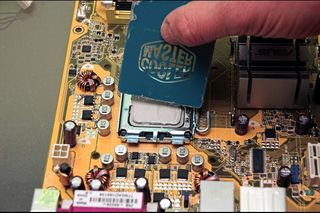Expert advice on chips and chipsets
It's all change (but business as usual) for processors
On the chipset side, the first round of new Core 2 processors will launch with an FSB of 1333MHz and be supported by the existing P35 and X38-based motherboards. Of the two, X38 is the more expensive, high-end board which can run two AMD graphics cards in Crossfire mode at full speed, thanks to its support for high bandwidth PCI Express 2.0. Both are capable of using DDR3 RAM too, but unless you're going to be doing some serious overclocking, the price premium of that over DDR2 isn't worthwhile right now.
AMD, meanwhile, have been slow to respond. The brand new Phenom processors, based on the new Agena cores, are just appearing, and the first few reviews of the server version of the chip, Barcelona, suggest that its performance isn't as good as AMD had hoped. Phenom itself is broadly similar to the Athlon 64, with a few tweaks that mirror Intel's revisions that created Core 2. These are mostly to do with the way data is prefetched to the chip and stacked for out-of-order processing, increasing its efficiency by anything between 5-50% in real world performance tools. The key advantage AMD have remains in their on-board memory controller and low latency core-to-core communication. As far as two or even four cores are concerned, however, the rapidly accelerating FSB of Intel's chipsets will tend to eclipse that. When it comes to eight-chip server boxes, it's advantage AMD, but at this point it's hard to see how AMD are going to lure gamers back to their fold. More importantly for Intel, AMD are only just changing over to a 65nm process for their new chips, while the new Core 2 CPUs will be built using a 45nm process, which means lower power requirements and higher potential clockspeeds.

There is some good news for AMD fans, however. Even if they can't compete clock for clock with Core 2 chips, they are expected to release high-end quad core Phenoms at low prices, just as they did with the X2900HD graphics card. Secondly, the new RD790 motherboard chipset is an overclocker's dream: even the voltage to the graphics slots can be increased so you can do away with the six pin power supply to your 3D card. On a slightly odder note, AMD have also announced they will be selling three-core versions of their desktop chips, filling the price gap between dual and quad cores with an interesting variant.
Even if the skeptics are proven right and Intel continues to hold the performance crown, it's too early to write AMD off yet: the end of 2008 will see another brand-new architecture launched, based on the fantastically named 'Bulldozer' core.
Sign up to the GamesRadar+ Newsletter
Weekly digests, tales from the communities you love, and more
Most Popular


